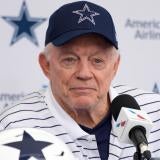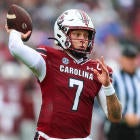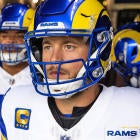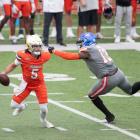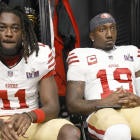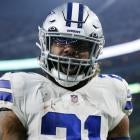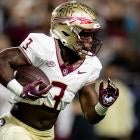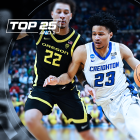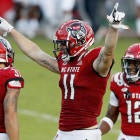Training camp is officially underway in the NFL, with the Ravens and Bears already on the field prepping for the 2018 season. This year's draft was high on drama thanks to the interest around the quarterbacks, but there are plenty of other players worth keeping an eye on as the regular season approaches.
Let's take a look at the assortment players I'm watching during training camp and preseason to see if they have what it takes to make an early impact on the 2018 NFL season.
Players listed here are, at the very least, somewhat under-the-radar. For example, listing Saquon Barkley here was not the goal. He's in store for the lion's share of backfield touches for the Giants as a rookie. We all know that.
 Michael Gallup, WR
Michael Gallup, WR
Where to start with Gallup? He was my No. 32 overall prospect -- and WR3 behind Courtland Sutton and James Washington -- in the 2018 draft class. He somehow lasted until the third round and landed in an amazing situation in Dallas. The Cowboys lost 272 targets from their 2017 squad, the highest figure in the NFC, and he's only looking at Allen Hurns and Cole Beasley ahead of him on the depth chart.
All that led to him being my Offensive Rookie of the Year selection in May. A receiver has won the award just three times in the last 15 years (Anquan Boldin in 2003, Percy Harvin in 2009, and Odell Beckham Jr. in 2014), so recent history isn't exactly on my side.
But Gallup's an ultra-polished receiver who does everything well albeit unspectacularly -- route running, ball-tracking, yards-after-the-catch. If anything, it'd benefit Gallup, the Cowboys offense and my OROY pick, if the former Colorado State standout improved in a specific area to make it a clear-cut strength and trump card.
 Christian Kirk, WR
Christian Kirk, WR
I wasn't as high on Kirk as the masses or the Cardinals were. He was my 129th overall prospect (fourth-round value), but Arizona's front office nabbed him in the second round at No. 47 overall. He just didn't seem as twitchy or play with as much burst as the hype, which led to disappointing work after the catch. Kirk's combine performance lent more credence to those thoughts and generated a rather blah MockDraftable Web, with agility drills (three-cone, short shuttle, and long shuttle) in the 23rd, 6th and 5th percentiles respectively among all combine receivers starting in 1999.
And, he predominately worked in the slot at Texas A&M, which is precisely where Larry Fitzgerald has thrived late in his career with the Cardinals. So it's an awkward schematic fit. Just because I didn't love Kirk as a prospect doesn't mean I'll ignore him as a rookie. Here's the veteran depth chart in front of him to start camp; Chad Williams, J.J. Nelson, and Brice Butler. Clearly, Kirk has a fine opportunity to emerge as the No. 2 receiver option for either Sam Bradford or Josh Rosen, and after spending a second-round pick on him, the Cardinals will give him every chance to move into that role right away.
Kirk must prove he can not only create separation on the perimeter but evade tacklers with the ball in his hands with some regularity to find the important niche as Fitzgerald's apprentice early in his NFL career.
 Courtland Sutton, WR
Courtland Sutton, WR
In 2017, reliable vets Demaryius Thomas and Emmanuel Sanders ate 232 of the team's 566 targets (40.9 percent) ... and gone are 208 more targets from a season ago due to the departures of Bennie Fowler, C.J. Anderson, A.J. Derby, Cody Latimer, Jamaal Charles, and Virgil Green. So yeaaaah, despite being firmly behind Thomas and Sanders on the depth chart, Sutton should have the inside track on being the team's third wideout.
And while offensive coordinator Bill Musgrave inherits a two-headed monster at receiver like the one he had during the Raiders' breakout 2016 season (with Michael Crabtree and Amari Cooper), third-option Seth Roberts was still targeted 77 times that year.
I adored Sutton as a prospect -- he was No. 5 overall on my Big Board and my top receiver -- and viewed him as much more than a big body who could rebound in the end zone. He was deceptively slippery and fluid with the ball in his hands. According to Sports Info Solutions, Sutton averaged 5.72 yards-after-the-catch per reception for SMU in 2017, a figure actually higher than Kirk's (5.22). Running hard-to-distinguish routes will be Sutton's biggest hurdle to clear as a rookie, but how quickly he begins producing will have a big impact on Denver's offense in 2018.
 Austin Corbett, OT
Austin Corbett, OT
Corbett's probably taking over for Joe Thomas at left tackle this season, so the size of the shoes he's filling makes him an offensive linemen worth monitoring closely this summer.
He'll battle Shon Coleman for that starting blindside protector gig, and whoever wins that job will have a unique test on their hands with the nimble Tyrod Taylor or improvisational Baker Mayfield under center this season. While both quarterbacks can help their blockers by eluding pass-rushers, their scrambling skills can prolong plays, which can put offensive linemen in precarious situations.
Corbett's violent hand usage and above-average mobility to the second level were strengths of his game at Nevada. I want to see how quickly and comfortable he is in his kick slide against quick and long NFL edge-benders. Also, is he strong enough yet to drop a sturdy anchor when facing outside rushers who convert speed to power? To start though, I wouldn't be shocked if he beats Coleman in camp. Actually I'll be surprised if he's not Cleveland's starting left tackle Week One.
 J'Mon Moore, Marquez Valdez-Scantling, Equanimeous St. Brown, WRs
J'Mon Moore, Marquez Valdez-Scantling, Equanimeous St. Brown, WRs
In the early portions of the 2018 draft, many wondered, including myself, why the Packers repeatedly passed on selecting a receiver. After picking two cornerbacks and a linebacker, Moore was taken in Round 4, then two similar prospects in Valdez-Scantling and St. Brown were added in Rounds 5 and Rounds 6. It may have simply been the way the draft fell, but the trio of pass-catchers grabbed by Green Bay indicates new GM Brian Gutekunst had a type he wanted at that position.
Moore, Valdez-Scantling, and St. Brown are tall, somewhat lanky and raw linear players with flashes of freaky, Martavis Bryant/Josh Gordon type downfield explosiveness. Aaron Rodgers has made many average receivers productive, and there's just not much experience behind Randall Cobb and Davante Adams in the Packers' wide receiver room. I'll be watching who from this comparable rookie trio takes advantage of the departure of Jordy Nelson and becomes a star under Rodgers' guidance. All three must get more sudden in their route running. More so than anything, they need to showcase their size-and-speed combo with the ball in their hands to earn 40-60 targets as a rookie. Keep your eye on Moore running slants. He dominated on that route at Missouri.
 Martinas Rankin, OT
Martinas Rankin, OT
Rankin was borrrrr-ing to watch at Mississippi State, a compliment for an offensive linemen. From the technical side of the game, I have no concerns about Rankin. He has light feet, plays with a timely, powerful punch, and is rarely caught off balance against any type of rusher.
He doesn't play with loads of power though, and the majority of young offensive linemen have -- recently -- struggled as pros because they're just not what I call "NFL strong" until their second or third seasons in the league. Rankin will find himself with a distinct possibility to block the left side for Deshaun Watson in Houston, and the blocker's main competition is 2017 fourth-rounder Julie'n Davenport who didn't do anything to earn that spot long-term as a rookie.
Watson had a brutal 8.5% sack rate in his seven games last year, which would've been the 5th-highest percentage among qualifiers had he been one himself. Coming off a torn knee ligament, it's an absolute must for the Texans to provide their potential franchise quarterback with better protection. It's not just about whether or not Rankin can beat out Davenport in camp and the preseason but how effective he is once the games start to count.
 Daurice Fountain, Deon Cain, WRs
Daurice Fountain, Deon Cain, WRs
Let's go ahead an assume Andrew Luck is back to his normal awesome self this year. I mean, he's been sidelined for well over a calendar year now. Looking back at the 2016 campaign, which, believe it or not, was an underrated season-long performance for Luck, T.Y. Hilton and Jack Doyle combined for a 230 targets out of 584. The third through seventh finishers in targets from that year are no longer on the team. After Hilton, Fountain and Cain really only have to look up at free-agent acquisition Ryan Grant on the depth chart.
Hello, opportunity. Cain was my No. 115 overall prospect in the 2018 draft. Fountain was No. 157. Both are smooth downfield gliders who really cover some ground despite seemingly exerting modest effort. Cain did run 4.43 at the combine, and Fountain timed in at 4.51 and jumped 42.5 inches at his Pro Day. The explosiveness is clearly there with both of these pass-catchers, and with Hilton drawing No. 1 corners each Sunday, one if not both of the rookies will likely face lower-level cover guys on a regular basis.
In 2015, 22-year-old Donte Moncrief racked up 64 receptions, 733 yards, and six touchdowns with Andrew Luck and Matt Hasselbeck under center. Fountain and Cain combining for a better stat line as rookies is doable. Athleticism won't be a factor for either wideout. Fountain will have to learn the nuances of betting press coverage in the NFL. Cain's hands must be more reliable than they were in his final campaign at Clemson.
 Marcus Davenport, EDGE
Marcus Davenport, EDGE
Many ridiculed the Davenport selection because of the major price -- 2019's first-rounder -- and a belief he's not "ready" to contribute as a rookie. I loved the aggressiveness by the Saints, especially with the Drew Brees' Super Bowl window closing and because I see no reason why Davenport can't wreak havoc opposite Cam Jordan in his debut professional season.
Sure, he'll go from facing Conference USA tackles to NFL tackles, but Davenport's a speed-to-power monster with long arms, a respectable array of pass-rushing moves, and a high motor.
New Orleans were getting a lot out of Alex Okafor before his injury a season ago, and Davenport has more natural ability. I'll be watching Davenport's progress early on. If he plays with the amount of tenacity he showed on the last day of practice at the Senior Bowl -- when he was legitimately unblockable -- the Saints will be flat out ridiculous on the defensive side of the ball with the playmakers they have in the secondary reaping the rewards of one of the NFC's most underrated pass-rushing groups.
 Fred Warner, LB
Fred Warner, LB
When healthy during his rookie season in the NFL, Reuben Foster looked exactly like he did at Alabama. Total game-wrecker. He's suspended for the first two games of 2018, and San Francisco opens with the Vikings and Lions. Unheralded vet Korey Toomer could be in line to jump into Foster's spot for those outings, but Warner has the refined game and agility to be a similar sideline-to-sideline thumper for the 49ers.
At BYU, Warner was routinely capable of dispatching blocks to get to the football, and, as evidenced by his impressive 6.90 three-cone time and 38.5-inch vertical, more than enough athleticism to mirror ball-carriers and stay with tight ends in coverage.
In front of him on San Fran's defensive line are three former first-round picks, so Warner should be kept relatively clean against the run. As is the case with most young linebackers, he'll face the biggest challenge in coverage. And more point-of-attack strength than what he showed in college will be necessary. The 49ers need to weather the storm early, and Warner is a sleeper worth paying attention to in camp to see if he can resemble Foster in September.
 Harold Landry, EDGE
Harold Landry, EDGE
Last year, Brian Orakpo logged 938 defensive snaps. Derrick Morgan was on the field for 827 plays. Orakpo will be 32 when the regular season starts. Morgan's 29. I'm assuming Tennessee picked Landry in the second round to be a complement to those two proven edge-rushers in 2018 then move into a prominent position as he grows at the professional level.
Landry was a polarizing prospect, mainly because in 2016, he looked like a top 15 pick then in an injury-riddled 2017, he played like a mid-rounder. The former Boston College star had the most scintillating pairing of burst and bend around the corner. His 6.88 three-cone drill was in the 95th percentile among combine edge-rushers over the past 20 years, and his 36-inch vertical placed him in the 82nd percentile.
The main issue I had with Landry's game was its lack of variety. If he didn't win with a blazing speed rush, the play was over for him. Don't get me wrong, that speed rush is Vic Beasley-like, but if Landry is to emerge as a star in the NFL -- and many believe that's in the cards for him -- he'll need to develop effective pass-rushing moves and counters off his outside rush. If he demonstrates more refinement at the pass-rushing apex as a rookie, the Titans defense will take a sizable step forward with what would be three quality edge-rushers.
 Derrius Guice, RB
Derrius Guice, RB
Guice's fall to the No. 59 overall selection in the draft was completely befuddling, and any specific examples or instances were never cited for the "maturity" or "off-field" concerns that apparently precipitated the plummet. I'm firmly in the camp of those who viewed Guice as a superior prospect to former teammate and top-five selection Leonard Fournette. Guice runs just about as powerfully as Fournette and is undeniably more elusive at the second and third levels of the defense.
He and 2017 fourth-round pick Samaje Perine formulate a thunderous duo that won't be fun tackling.
I want to see if Guice grabs the "feature back" spot from Perine as a rookie or if the two seem destined for a legitimate 50-50 split in their ball-carrying committee. I have no worries about Guice running inside, and I know he'll consistently finish his runs with brute force. However, he needs to play to his 4.49 combine speed to maximize the occasions when Washington's offensive line opens huge holes for him.








